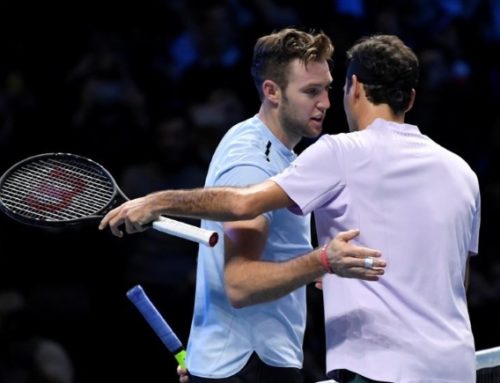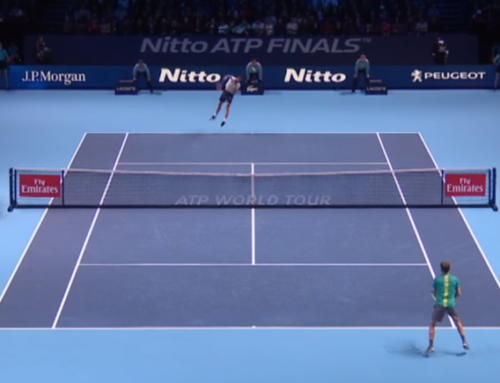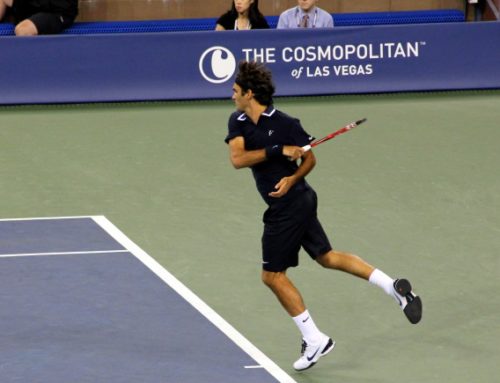At Tactical Tennis we’ve talked about the similarities between the games of Dimitrov and Federer before – Dimitrov’s slowly fading nickname of “Baby Fed” is not happenstance. As such the match between Nadal and Dimitrov has greater significance for Federer than everyone else. For him it provides an opportunity to see, in live play, someone with a remarkably similar style of game tackle the tactical challenges that Nadal has to offer. Clearly Dimitrov is doing something right – despite his relatively lowly ranking and ‘up and comer status’ he’s pushed Nadal to a third set in all three of their previous meetings at small tournaments. Then, last night, Dimitrov pushed Nadal towards the edge in coming within a handful of points from victory. So what is Dimitrov doing right against Nadal? What can Federer take away from this match and carry into his semi-final against Nadal on Friday?
Nadal’s Game Plan
To ensure we are all on the same page it is important to, at least briefly, talk about Nadal’s game plan. Nadal’s goal is relatively simple – to break down the one-handed backhand. By focusing the vast majority of his play there he can both dictate play and fatigue his opponent. It is a pattern we’ve seen play out over and over in Nadal and Federer’s long and storied history – Nadal pounding high and heavy balls into Federer’s backhand until slowly the unforced errors begin, at first with a trick and finally in a cascade that results in a Nadal victory. The reason this happens is once the contact point for the one-handed backhand moves above the shoulder, the strength of the muscles pulling the arm and racket around (primarily the rear deltoid) is noticeably lower. Since the muscle is operating closer to its limit up there, it fatigues more quickly, which encourages players to use too much of their hips to compensate, thus reducing the stability of the stroke and causing an increase in errors. Additionally the decreased strength above the shoulder means the one-handed backhand player can generate less power, meaning it is harder for them to hurt you.
This forehand into the opposing backhand is the centerpiece of Nadal’s game plan. Based off of this he can fall into a variety of familiar patterns, earning shorter forehands in mid-court which he then finishes the point with. It’s clear watching him play Dimitrov that he’s dusting off the Federer Game Plan and putting it to good use. An astonishing 84% of Nadal’s first serves on the deuce court went to Dimitrov’s backhand, and 71% to the backhand on the ad court. Meanwhile Dimitrov served less than 50% of his first serves to the Nadal backhand on the deuce court, and only 61% on the ad court. By serving to the backhand, Nadal is increasing the chances of his first ball after the serve being a forehand, which then allows him to choose the initial pattern the point will begin with.
All this is well and good, but what did Dimitrov do that allowed him to foil Nadal’s game plan to a large extent?
1) Serve For The Corners
It’s hard to over-stress the importance of stretching Nadal on the return. Nadal fights off the body serve well, but Dimitrov did a great job of making Nadal reach for returns on both wings. This earned him a large number of short, mid-court forehands which he abruptly finished the point with. Particularly effective was the wide serve on the deuce court – a serve Federer usually excels at.
2) Know When To Pull The Trigger
One thing was clear from early on – Dimitrov wasn’t afraid to have long rallies with Nadal. In recent years Federer has been too quick to try to end the point against Nadal, especially off the forehand wing. Dimitrov was quite content to use his big forehand to control rallies, hitting with heavy spin into the Nadal backhand. Then, when he got the short ball (particularly off the return) he pulled the trigger and ended points with aplomb. Federer must be willing to be patient off the forehand wing, and earn the shorter balls he can then take chances on.
3) Use The Slice To Effect
Of all the things Dimitrov did well in this match, his use of the slice was at times brilliant. A key part of Nadal’s game plan is the breaking down of the one-handed backhand. Nadal loves to use his forehand to play puppet-master, jerking his opponents around the court with heavy spin. Ironically Dimitrov frequently turned the tables on Nadal in a very subtle way. He was very happy to play a deep, slow slice back to Nadal’s forehand in that cross-court rally, then periodically throw in a shorter slice down the line into the Nadal backhand. Suddenly instead of Dimitrov running all over the court, he was standing in the backhand corner and forcing Nadal to be the one doing the hard work. The slice backhand isn’t near as fatiguing as the one-handed topspin backhand because the downwards motion of the stroke involves heavy use of the latissimus dorsi (a much larger muscle than the deltoid and thus less susceptible to fatigue). The end result of this was that Dimitrov was able to extend rallies with Nadal at a low energy cost.
4) Push-Pull
I’ve noticed several comments around the web this morning talking about how poorly Nadal played. What people fail to realize is that this is in large part due to the way Dimitrov played him. Dimitrov did an excellent job of what I call “Push-Pull” – pushing Nadal back on one shot, then pulling him forward on the next ball. The pulls were rarely short enough for Nadal to treat them as approach shots, but what this did was disrupt Nadal’s excellent lateral movement and force him into movement patterns he uses far less often. By putting Nadal in such unfamiliar court positions, especially off lower, low pace balls (see the slice comments above), Nadal struggled to deal with the ensuing changes of pace and depth. Multiple times I saw him miss routine balls midway through a rally after several changes of pace from Dimitrov. Even more interesting was how often we saw Nadal go to the slice backhand last night, which is something he doesn’t like to do often. Dimitrov clearly made Nadal uncomfortable and took him out of his normal game.
5) Believe
Dimitrov took to the court like a man with a mission. This was not a nervous performance from the Bulgarian – for the first three sets Grigor played like a man who belonged. He wilted in the fourth set, but Federer should take heart from the fact that it was only then that Nadal began to look comfortable and truly in control. The courts are faster, Federer is moving better, and he is a significantly better player than Dimitrov. He could take the court, play Dimitrov’s exact game plan and come through purely by virtue of being better at pretty much everything on a court than Dimitrov is. Dimitrov’s performance should give Federer the confidence to believe he can take the match.
Federer has done a great job of sneaking into the net to finish points throughout the tournament so far – whether this is Edberg’s influence or not is difficult to say but he’s not looked this sharp in his reading of the game in several years. Federer is also showing a level of defense we’ve not seen from him in some time. The question isn’t whether or not Federer can win the match. The question is, when Federer takes the court on Friday will he be alone, or will the ghosts of failures past follow in his wake whispering defeat in his ear? With the top half of the draw looking relatively empty now, this may well be Federer’s best chance to take #18. In the same manner that Sampras played Agassi in the 2001 US Open final, it is only fitting that Nadal should be the man standing now in Federer’s way.


